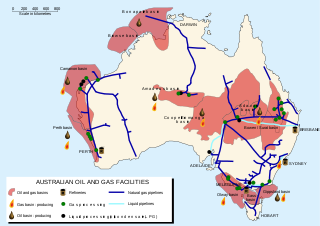This article has multiple issues. Please help improve it or discuss these issues on the talk page. (Learn how and when to remove these messages)
|


The energy policy of Australia is subject to the regulatory and fiscal influence of all three levels of government in Australia,[citation needed] although only the State and Federal levels determine policy for primary industries such as coal.[1] Federal policies for energy in Australia continue to support the coal mining and natural gas industries through subsidies for fossil fuel use and production.[2] Australia is the 10th most coal-dependent country in the world.[3] Coal and natural gas, along with oil-based products, are currently the primary sources of Australian energy usage and the coal industry produces over 30% of Australia's total greenhouse gas emissions.[4] In 2018 Australia was the 8th highest emitter of greenhouse gases per capita in the world.[5]
Australia's energy policy features a combination of coal power stations and hydro electricity plants. The Australian government has decided not to build nuclear power plants,[6] although it is one of the world's largest producers of uranium.
Australia has one of the fastest deployment rates of renewable energy worldwide. The country has deployed 5.2 GW of solar and wind power in 2018 alone and at this rate, is on track to reach 50% renewable electricity in 2024 and 100% in 2032.[7] However, Australia may be one of the leading major economies in terms of renewable deployments, but it is one of the least prepared at a network level to make this transition, being ranked 28th out of the list of 32 advanced economies on the World Economic Forum's 2019 Energy Transition Index.[8]
- ^ "Australia's energy strategies and frameworks | energy.gov.au". www.energy.gov.au. Retrieved 24 October 2021.
- ^ "Australian fossil fuel subsidies hit $10.3 billion in 2020-21". The Australia Institute. 25 April 2021. Retrieved 24 October 2021.
- ^ World Coal Consumption by Country
- ^ Cave, Damien (21 October 2021). "In Australia, It's 'Long Live King Coal'". The New York Times. ISSN 0362-4331. Retrieved 24 October 2021.
- ^ See Oak Ridge National Laboratory
- ^ "Nuclear power in Australia: is it a good idea?". cosmosmagazine.com. 5 October 2021. Retrieved 18 June 2022.
- ^ "An Australian model for the renewable-energy transition". www.lowyinstitute.org. Archived from the original on 8 July 2019. Retrieved 8 July 2019.
- ^ "Fostering Effective Energy Transition 2019". Fostering Effective Energy Transition 2019. Archived from the original on 23 November 2021. Retrieved 8 July 2019.